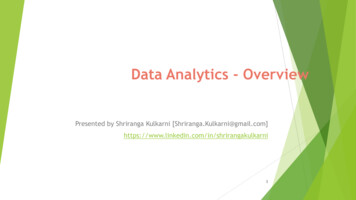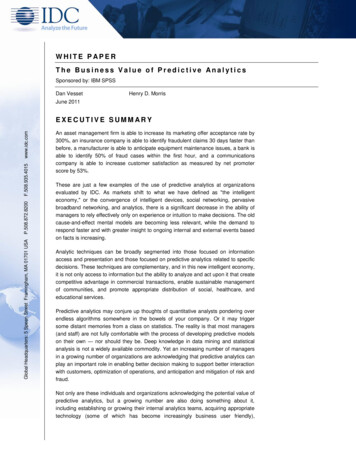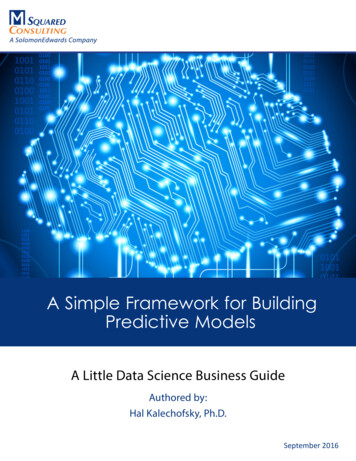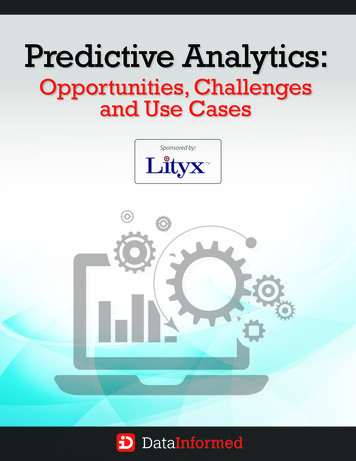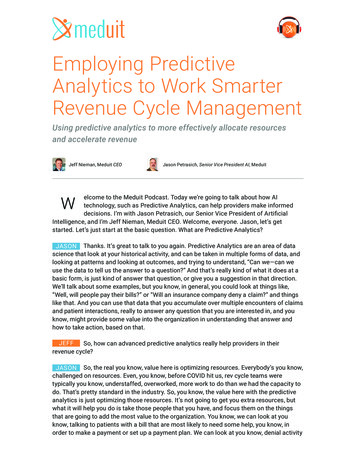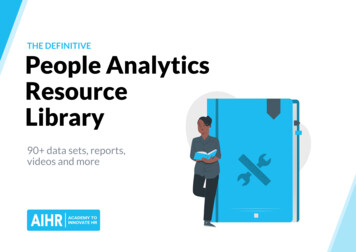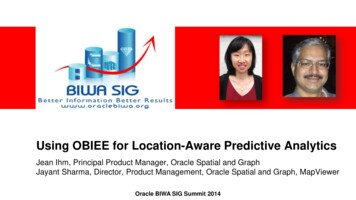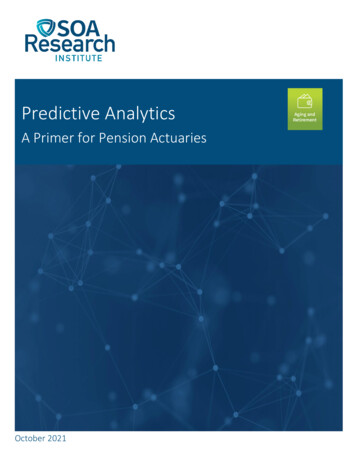
Transcription
Predictive AnalyticsA Primer for Pension ActuariesOctober 2021
2Predictive AnalyticsA Primer for Pension ActuariesAuthorsDavid R. Cantor, ASA, CFA, FRMKailan Shang, FSA, CFA, PRM, SCJPSponsorAging and Retirement StrategicResearch Program SteeringCommitteeCaveat and DisclaimerThe opinions expressed and conclusions reached by the authors are their own and do not represent any official position or opinion of the Society ofActuaries Research Institute, Society of Actuaries, or its members. The Society of Actuaries Research Institute makes no representation or warranty to theaccuracy of the information.Copyright 2021 by the Society of Actuaries Research Institute. All rights reserved.Copyright 2021 Society of Actuaries Research Institute
3CONTENTSExecutive Summary .4Section 1: Introduction .6Section 2: Predictive Modeling with an Example .82.1 Exploratory Data Analysis .102.2 Data Cleaning .152.3 Predictive Model .152.3.1 Supervised Learning .162.3.2 Unsupervised Learning .192.4 Model Training and Validation .202.5 Result Communication .232.6 Model Implementation.24Section 3: Literature Review . 27Section 4: Case Study: De-risking Activity Prediction . 314.1 Data Preparation .324.2 Predictive Model .354.3 Model Training, Validation and Selection .38Section 5: Conclusion . 41Section 6: Acknowledgments . 43References . 44Appendix A: Predictive Modeling in Condensed Form . 47A.1 Exploratory Data Analysis .48A.2 Data Cleaning .54A.2.1 Missing Data Treatment.55A.2.2 Data Normalization .55A.2.3 Feature Engineering .56A.2.4 Dimensionality Reduction .57A.3 Predictive Model .60A.3.1 Supervised Learning .60A.3.2 Unsupervised Learning .68A.3.3 Reinforcement Learning .72A.4 Model Training .73A.4.1 Error Function.73A.4.2 Overfitting.75A.4.3 Optimization Algorithm .78A.4.4 Hyperparameters .80A.5 Model Validation.81A.5.1 Regression Model Validation .82A.5.2 Classification Model Validation .83A.5.3 Feature Importance .85A.5.4 Unsupervised Learning Model Validation .88A.5.5 Reinforcement Learning Model Validation .88A.6 Result Communication .89A.7 Model Implementation.90Appendix B: Open-Source Python Program . 92About The Society of Actuaries Research Institute . 93Copyright 2021 Society of Actuaries Research Institute
4Executive SummaryThe growing availability of data has changed the landscape of analytics on data processing, predictive models, andgranularity of analysis. Changes are happening in the pension and retirement field to utilize the data and predictivemodels for better analysis and decision-making.This report introduces predictive analysis to pension actuaries in a concise and practical way. We cover the threetypes of models used in predictive analytics: supervised learning, unsupervised learning, and reinforcement learning.By using a simple case study on relative mortality prediction at the U.S. county level using demographic andeconomic information, we introduce the standard predictive modeling process, as shown in Figure E.1. Withillustrations and explanations of all the connected components in the process, actuaries get a high-level picture ofhow a real-world application of predictive analysis can be applied by those in the pension/retirement domain.Figure E.1PREDICTIVE MODELING SAMPLE PROCESSData ExplorationData CleaningModel Validation Data Validation Feature Engineering Dimensionality Reduction Examine different model types Hyperparameters Error Function OverfittingCalibrationModel Training Descriptive Statistics Relationships Data Visualization Goodness-of-fit Measures Scatter Plots Feature ImportanceResult Communication Result Visualization Model SelectionModel Implementation Prediction Process Model UpdatingTo explore the existing applications to the pension/retirement field, a thorough review of existing applications isconducted, with a focus on mortality modeling, pension plan risk transfer, liability driven investment and assetallocation, and retirement decision-making and defined contribution plans. At the same time, areas that predictivemodeling may be applied to improve the pension industry are identified.To further demonstrate the potential application of predictive analysis, another but more complicated case study isused. Here we use predictive analytics to predict de-risking activity. We use 11 years of IRS Form 5500 data toCopyright 2021 Society of Actuaries Research Institute
5predict whether an individual single-employer plan will have de-risking activities in the next year given the currentplan information reported in Form 5500 and its schedules. This prediction task can be formulated as a classificationproblem and solved. This provides an additional useful case study to complement the regression type problem usedin the introductory example on relative mortality prediction.Through these new and carefully designed examples, we keep the focus on important concepts as opposed totechnical details. At the same time, these relevant examples can be used as a foundation, and hopefully inspiration,for other applications in the pension/retirement field.More methods and models are discussed in the Appendix to reinforce and expand what is covered in the casestudies and core of the report. Python codes used for the case studies are also made available for educationalpurpose and hosted at -Analytics-for-Retirement.To our knowledge, our paper is the first to contribute directly to the applications of predictive modeling to pensionand retirement problems.Copyright 2021 Society of Actuaries Research Institute
6Section 1: IntroductionLike many other industries, the pension industry is experiencing changes brought about by predictive analytics, theavailability of more data, and advanced technologies. Social insurance programs, employer sponsored pensionplans, and individual retirement planning are adapting to these new developments. In general, predictive analyticscan help understand and predict demographic changes, financial behavior and facilitate better retirement decisionmaking.Predictive analytics is statistical analysis aimed at making predictions about future or unobservable outcomes usingdata and techniques such as statistical modeling and machine learning. Actuaries have been working with predictivemodels such as linear regression and generalized linear models (GLMs) for a long time. However, with theadvancement of better computing technologies, a few things have changed in the past few decades. Algorithms used for traditional statistical models changed with much larger data volume available thanbefore. For example, in linear regression 𝑌 𝑋𝛽 𝜀1, the ordinary least squares method will estimate 𝛽as (𝑋 ′ 𝑋) 1 𝑋 ′ 𝑌2. However, when the dataset is large, calculating (𝑋 ′ 𝑋) 1 becomes challenging and it ismore likely to encounter singularity or near singularity issues where the inverse matrix cannot becalculated. What this means is the solution cannot be found. Other methods are widely used instead, suchas the gradient descent method which is an iterative optimization algorithm that gradually adjusts 𝛽 tominimize the predication error 𝜀.Many models that were not practical in the past have become popular with the availability of increasingcomputing capabilities. For example, artificial neural networks (ANNs) were first developed by Rosenblatt(1958) to model information storage and organization in the brain but became popular only about twodecades ago given increased computing power.In traditional statistical models, emphasis has been put on hypothesis tests such as the t-test and the F-testto evaluate model accuracy. With more data available, model validation has become more data drivenwhere the entire dataset is usually split into training data and validation data. Validation data is notobservable during model training but used to assess the accuracy of prediction. Hypothesis tests are lessused, partially because some models have formats that are too complicated with too many parameters,and partially because data driven model validation is enough to assess model accuracy. The focus ofpredictive analytics tends to be on making accurate predictions whereas classic statistics tends to focusmore on building models with intuition and clear explanatory variables.Along with technological developments and increasing data availability, new buzzwords such as big data analytics,machine learning, deep learning and artificial intelligence (AI) have appeared. Although these buzzwords have theirspecific focus on data volume, model types, or applications, they have overlaps with predictive analytics. From amodeling perspective, they share the methods and overarching approach of data processing, examining differentpotential model types, training the potential models and then performing validation.This report will start by introducing the typical predictive modeling process including data processing, model choice,model training, model validation, and results interpretation. Readers will be able to understand the kind of problemsthat predictive modeling can help solve, different tools and models that are available to perform the analysis, andways to assess model accuracy and address important issues such as overfitting.Y is a vector that contains all the data records of the response variable. X is a matrix containing ones and the values of the explanatory variables. 𝛽 is theparameters of the linear function and 𝜀 is the residual errors that cannot be explained by the linear function.2 𝑋 ′ Is the transpose of matrix X. (𝑋 ′ 𝑋) 1 is the inverse of matrix 𝑋 ′ 𝑋. These are standard linear regression formulas written in matrix form as found inelementary statistics textbooks.1Copyright 2021 Society of Actuaries Research Institute
7We proceed as follows: Section 2 (Predictive Modeling with an Example) introduces predictive modeling with a mortality predictionexample. Using U.S. county level data including mortality, demographic and economic information, thissection shows a subset of tools and models used in predictive analytics but provides a comprehensiveoverview of a typical predictive modeling process including data processing, model choice, model training,model validation, result communication and model implementation. Readers will be able to understand thekind of problems that predictive modeling can help solve, different tools and models that are available toperform the analysis, and ways to assess model accuracy and address important issues such as overfitting.Section 3 (Literature Review) discusses the areas that predictive modeling may be applied to improve thepension industry. It includes both existing and potentially future applications and research. This helpsreaders better understand the potential impact of predictive analytics on pension and retirement in thefuture.Section 4 (Case Study: De-risking Activity Prediction) uses Form 5500 data published by the U.S.Department of Labor and studies the demographic profile, fund contribution, asset allocation, fundingstatus, demographic profile, and actuarial assumptions using plan level data to identify useful data, trend,and patterns for pension plan management. It builds a prediction system to identify plans that may haverisk transfer activities in the near future. Supervised learning is applied with a detailed explanation of datapreparation, model training, model validation, and model selection.Section 5 (Conclusion) summarizes the key points of this research and concludes the main body of thereport.Appendix A (Predictive Modeling in Condensed Form) provides a comprehensive overview of predictivemodeling. We encourage interested and advanced readers to review the Appendix. We have deliberatelydesigned Appendix A to mirror the body of the report but with more details and examples. Therefore,topics can be read at a high-level in the body of the report and further explored in the parallel area of theAppendix.Appendix B (Open-Source Python Program) describes the Python programs built for this research that arepublicly accessible.Copyright 2021 Society of Actuaries Research Institute
8Section 2: Predictive Modeling with an ExampleUsing a simple yet relevant topic as an example, this section introduces some of the basic elements of a predictiveanalytical task including data, model selection, and prediction. Discussions of modeling choices are avoided in thissection but covered in Appendix A, to make this section as light as possible. The idea here is not to get obsessedwith all the details but to understand the process and core concepts so that other problems can be approached inthe same mechanical and systematic way.Geolocation has been widely used in insurance pricing for a long time, such as life products that protect againstdeath events, and non-life insurance products like auto insurance. For the pension industry, geolocation of planparticipants can help evaluate the aggregate mortality rate of a pension plan. It may also be beneficial for individualretirement planning, recognizing that other factors such as age and health conditions may have a bigger impact onmortality. In this example, we try to predict the U.S. county level mortality rate compared to the national averagemortality rate.Two datasets are used in the relative mortality example: United States Mortality Rates by County 1980-2014 by Global Health Data Exchange3. It provides mortalityrates of 3,142 counties due to 21 mutually exclusive causes of death.2016 Planning Database by U.S. Census Bureau4. It provides information about urbanization, gender, age,race distribution, education level, health insurance, and household incomes for each county.Table 1 lists the final variables used in this example. The response variable “MR Relative” which we want to predictis defined as the county level mortality rate divided by the national average mortality rate. The explanatory variablesthat are used to explain the response variable contain some high-level demographic and economic information.Some of the explanatory variables are created based on the original dataset to better represent the information wewant to use for this analysis.3Institute for Health Metrics and Evaluation (IHME). United States Mortality Rates by County 1980-2014. Seattle,United States: Institute for Health Metrics and Evaluation (IHME), nited-states-mortality-rates-county-1980-20144The U.S. Census Bureau, 2017. “2016 Planning ight 2021 Society of Actuaries Research Institute
9Table 1RELATIVE MORTALITY DATASET VARIABLESVariableNoteTypeMR RelativeRelative mortality multipleResponseland per capitaLand area (sq.mi.) per personExplanatoryurbanized pop pctPerc. of population living in Area defined as an UrbanizedArea (50,000 or greater)Perc. of population living in Area defined as an UrbanCluster Area (2,500-49,999)Perc. of population living in Area outside of an UrbanArea or Urban ClusterExplanatorymale pctPerc. of male residentsExplanatoryfemale pctPerc. of female residentsExplanatoryage 5 pctPerc. of age below 5Explanatoryage 5 17 pctPerc. of age 5-17Explanatoryage 18 24 pctPerc. of age 18-24Explanatoryage 25 44 pctPerc. of age 25-44Explanatoryage 45 64 pctPerc. of age 45-64Explanatoryage 65 pctPerc. of age 65 and overExplanatoryhispanic pctPerc. of Hispanic origin populationExplanatorywhite pctPerc. of White populationExplanatoryblack pctPerc. of Black and Africa American populationExplanatoryaian pctPerc. of American Indian and Alaska Native populationExplanatoryasian pctPerc. of Asian populationExplanatorynhopi pctPerc. of Native Hawaiian and Other Pacific IslanderpopulationPerc. of some other race populationExplanatorynot hs pctPerc. of people 25 years old and over who are not highschool graduatesExplanatorycollege pctPerc. of persons 25 with Bachelor's degree orhigherPerc. of people classified as below the poverty levelExplanatoryExplanatoryno health ins pctPerc. of people with one type of health insurancecoveragePerc. of people with two or more types of healthinsurance coveragePerc. of people with no health insurance coveragemed hh incMedian household incomeExplanatoryavg hh incAverage household incomeExplanatorymed house valueMedian house valueExplanatoryavg house valueAverage house valueExplanatorystate avgAverage relative mortality at state levelExplanatoryurban cluster pctrural pop pctsor pctpoverty pctone health ins pcttwo plus health ins lanatoryExplanatoryOne question to answer before performing the analysis is why do we need to predict the relative mortality multipleCopyright 2021 Society of Actuaries Research Institute
10in the first place? If the county level relative mortality multiple is already known, it can simply be applied to adjustthe mortality assumption at the county level. For applications in the pension field, the relationship found at thecounty level can be applied at a more granular level such as to zip codes. For instance, say we know the relativemortality for Westchester County in New York. There are numerous zip codes within Westchester County. Mortalitydata is not publicly available at the zip code level. We can, however, collect explanatory variables at the zip codelevel and then map those to a representative county or set of counties. If we know the relative mortality of thecount(ies) we can then use this as a proxy for the relative mortality at the more detailed zip code level.Figure 1 shows a typical predictive modeling process, which is composed of two major parts: calibration andimplementation.Figure 2PREDICTIVE MODELING SAMPLE PROCESSData ExplorationData CleaningModel Validation Data Validation Feature Engineering Dimensionality Reduction Examine different model types Hyperparameters Error Function OverfittingCalibrationModel Training Descriptive Statistics Relationships Data Visualization Goodness-of-fit Measures Scatter Plots Feature ImportanceResult Communication Result Visualization Model SelectionModel Implementation Prediction Process Model UpdatingThe rest of this section explains each component in the process using the example of relative mortality prediction.2.1 EXPLORATORY DATA ANALYSISAs the first step in predictive modeling, exploratory data analysis (EDA) is a model-free approach to summarize dataand relationships among variables using descriptive statistics and visualization. The goal of EDA is to provide anoverview of the data and spot any interesting trends or relationships that may be helpful for constructing predictiveCopyright 2021 Society of Actuaries Research Institute
11models and validating the results. Pension actuaries already employ a version of EDA in their standard valuationactuarial reports when they plot metrics such as trends in funded status and population statistics.Descriptive statistics, correlation, and data visualization are typical tools used during EDA to find prominent andsimple patterns. Table 2 shows some descriptive statistics of the variables used as explained in Table 1.Table 2SAMPLE DESCRIPTIVE STATISTICSVariableMR 981.093rdQuartile1.22land per capita0.100.680.000.010.020.0426.04urbanized pop pcturban cluster pct30%21%35%21%0%0%0%4%6%16%61%34%100%100%rural pop pctmale pct49%50%29%2%0%45%26%49%46%49%69%50%100%72%female pct50%2%28%50%51%51%55%age 5 pctMeanMinMedianMax2.096%1%3%6%6%7%13%age 5 17 pct17%2%7%16%17%18%27%age 18 24 pct9%3%2%8%9%10%47%age 25 44 pct24%3%14%23%24%26%43%age 45 64 pct28%3%10%26%28%29%45%age 65 pct15%4%3%13%15%17%33%hispanic pct9%12%0%3%5%10%96%white pct76%17%3%68%80%89%99%black pct9%12%0%1%5%14%78%aian pct2%6%0%0%0%1%83%asian pct2%3%0%0%1%2%43%nhopi pct0%0%0%0%0%0%11%sor pct0%0%0%0%0%0%3%not hs pctcollege pctpoverty 0%54%44%one health ins pct66%6%36%63%67%70%84%two plus health ins 42,16314%47,78616%54,56461%132,203no health ins pctmed hh incavg hh inc63,25913,97130,08654,29460,70369,175152,424med house 4avg house 0.110.820.981.031.111.30state avgDescriptive statistics can also be represented as graphs to provide an overview of the data in a vivid way. Figure 2shows the degree of urbanization, age mix and health insurance coverage.Copyright 2021 Society of Actuaries Research Institute
12Figure 2SAMPLE PIE CHARTSFigure 3 are the box plots that show the distributions of variables. Each box represents the data between the firstand third quartile (Q1 and Q3), with the line in the middle as the median. The box extends to wider data rangebetween [Q1 – 1.5(Q3 – Q1), Q3 1.5(Q3 – Q1)], where available. For outliers outside this range, they are plotted asindividual dots. It is clear that variables such as “land per capita”, “male pct”, “age 18 24 pct” and“med house value” are all right skewed.Figure 3SAMPLE BOX PLOTSDescriptive statistics are helpful for gaining a high-level understanding of the data. However, data can behavesignificantly differently with the same or similar descriptive statistics. Visualization is a powerful tool to further studythe details that may be missed in descriptive statistics. Figure 4 illustrates the relative mortality data on a map. ItCopyright 2021 Society of Actuaries Research Institute
13can help us set some benchmark about areas where mortality rates are relatively higher compared to nationalaverage.Figure 4U.S. MORTALITY LEVEL BY COUNTYTo explore the relationship among variables, correlation matrices in the format of a heatmap can be used to quicklyidentify highly correlated pairs. Figure 5 shows the heatmap of some selected variables in the dataset. It is notablethat the response variable is negatively correlated with household income(“med hh inc”), housevalue(“med house value”), college education(“college pct”) and positively correlated to poverty(“poverty pct”).Some explanatory variables such as household income(“med hh inc”) and house value(“med house value”) arehighly correlated.Copyright 2021 Society of Actuaries Research Institute
14Figure 5SAMPLE HEATMAPEDA is a general concept that contains all kinds of data exploration without formal modeling. What is describedabove is only a small portion of what is available in this field5.5Two recent books on the subject include, “How Charts Lie: Getting Smarter about Visual Information” and “The Truthful Art: Data, Charts, and Maps forCommunication”. Both are by Alberto Cairo and are recommended for readers who are more interested in this area.Copyright 2021 Society of Actuaries Research Institute
152.2 DATA CLEANINGAfter the EDA, it is easier to define the prediction task and determine what data may be used. However, before thedata can be fed into the predictive models, additional processing is often needed to adjust the data inputs topotentially improve model accuracy. Missing data treatment, data normalization, feature engineering, anddimensionality reduction are often used in the data cleaning process. In this simple example, part of the first threecomponents is used.Missing data is quite common, especially with large datasets. In the census dataset where demographic andeconomic information is stored, 33 out of 3,142 counties do not have household income and house value data,which are correlated with relative mortality level. Normally a few choices are available to treat data records withmissing data. They can be removed, replaced with average value or value in a similar data record, or flagged in anindicator variable to represent that the data is missing. In this example, all 33 records are removed considering thatthe volume of the remaining data is still large enough for a meaningful analysis.When explanatory variables have different levels of magnitude, they may need to be normalized so that theparameter calibration will not be dominated by a small portion of the variables, and therefore better reflect therelationship between response variable and explanatory variables. As shown in T
Predictive analytics is statistical analysis aimed at making predictions about future or unobservable outcomes using data and techniques such as statistical modeling and machine learning. Actuaries have been working with predictive models such as linear regression and generalize
